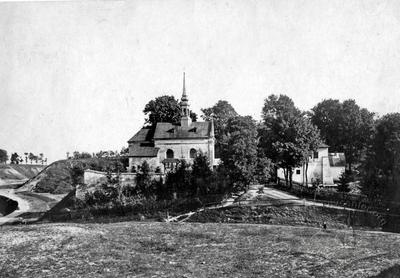
Church of St. Wojciech's, bishop and martyr, missionaries
- ID: 341
- Place: Lviv
The archaic appearance of Lviv's most famous square—the stone buildings and structures that had not yet been built, which ultimately gave the square its unofficial status as the city center. The triangular plane of this informal city center is located between Kopernika, Krutaya (now Voronogo), Akademicheskaya (Shevchenko Avenue), Galitskaya Square, Valovaya, Sobesko (Rogatynsky Brothers), Boim (Staroyevreyskaya), Teatralna, Hetmanska, and Karola Ludwika (even and odd sides of Svobody Avenue). The large space, which later formed as a square, was freed up with the demolition of the old fortification walls at the end of the 18th century. It was in this place that the Parish Bastion stood. During the development of the future square in 1839–1841, some old stone buildings were demolished and the Poltva River was covered, and then a well appeared in the center of the square. On July 29, 1843, the square was solemnly opened and named after the governor of Galicia in 1832–1846, Archduke Ferdinand d'Este. On this occasion, a festival was held in the Jesuit City, in which almost the entire population of the city took part. In the 1850s, the Lviv authorities attempted to transform Ferdinand Square into a kind of commercial center. After the St. George's fairs faded away, there were attempts to organize similar fairs in newly created city squares, including Ferdinand Square, but fortunately, the square never became a city market. In 1862, a marble statue of the Virgin Mary was erected in the center of the square on the site of the well, and from that time on, it was named Mariyatska Square. In 1904, the well with the statue of the Virgin Mary was moved to make way for a monument to Adam Mickiewicz. Almost every building or corner of Mariyatska Square was reproduced on postcards, and all the events and changes in the life of the city in the 19th and 20th centuries were reflected in the life of the square. It was here that Lviv's oldest hotels, the Georges (known since 1793 as the “Under Three Hooks” inn), were located, and from 1804, the European and French hotels existed. Mariacka Square was home to the famous bookstores of Bartolomej and Kaetan Jablonski, Franz Richter, Herman and Alfred Altenberg, the confectioneries of Karol Chudzjak and Kazimierz Socek, the Monopol coffee shop, Avenue, one of the top ten permanent cinemas in Lviv, Baika (later renamed Helios, Fata Morgana, Mirage, and I. Franko), and an extraordinary number of fashion stores, newspaper and magazine offices.